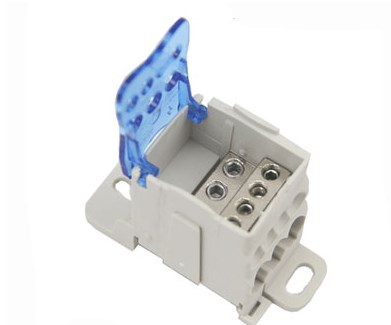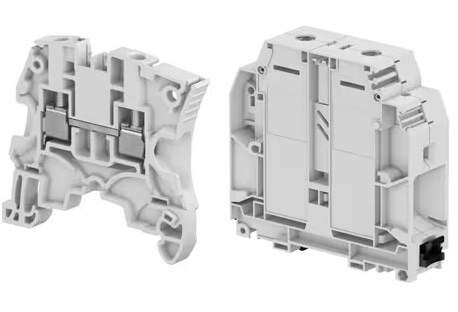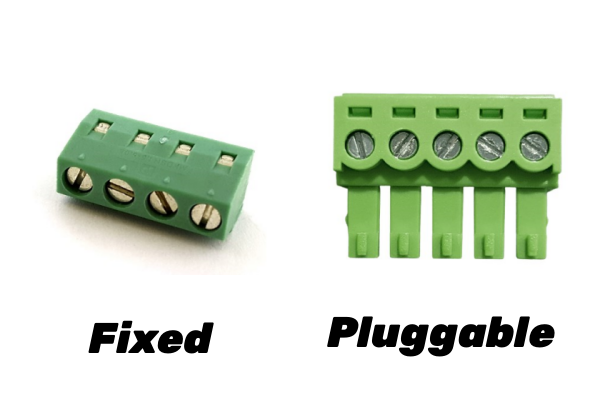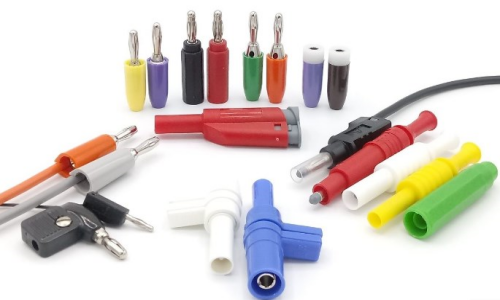A terminal block distributor is a component used in electrical and electronic systems to organize and distribute electrical connections effectively. Terminal blocks are modular, insulated blocks that secure two or more wires together, typically by clamping or screwing down the wires into place. A terminal block distributor refers to a specific type of terminal block setup typically used for distributing multiple wires or connections in a structured and organized manner.
Here are some key points about terminal block distributors:
-
Organization: Terminal block distributors help in organizing multiple wires or connections from one central location, making it easier to manage and troubleshoot electrical circuits.
-
Distribution: Terminal block distributors allow for the distribution of power or signals efficiently to different components or devices within a system.
-
Versatility: They come in various configurations and types to suit different applications, such as feed-through terminal blocks, ground terminal blocks, disconnect terminal blocks, and more.
-
Connection Methods: Terminal block distributors can feature various connection methods, including screw terminals, spring terminals, push-in terminals, or insulation displacement connections.
-
Mounting Options: They can be mounted on a DIN rail, a panel, or a printed circuit board, offering flexibility in installation depending on the specific requirements of the application.
-
Identification: Terminal block distributors often come with marking options to help identify and label each connection point for easy identification and maintenance.
-
Electrical Safety: They provide a safe and reliable way to make electrical connections, ensuring proper insulation and protection against electrical hazards.
Overall, terminal block distributors are essential components in electrical systems where multiple connections need to be made and organized effectively. They play a critical role in providing a structured and accessible way to manage electrical connections, which is key to ensuring the reliability and efficiency of complex electrical and electronic systems.

The Main Use of Terminal Block Distributor
Terminal block distributors serve a variety of crucial functions in electrical and electronic systems. The main use of a terminal block distributor is to efficiently and effectively manage the distribution of power, signals, and connections in a structured and organized manner. Here are some key uses of terminal block distributors:
-
Wire Termination: Terminal block distributors provide a secure and reliable way to terminate and connect multiple wires or cables in electrical circuits. They offer a central point to terminate conductors for power distribution or signal transmission.
-
Distribution of Power: Terminal block distributors are used to distribute electrical power from a single source to multiple destinations or devices. They allow for the easy and organized branching of power lines within a system.
-
Signal Distribution: In addition to power distribution, terminal block distributors can be utilized for distributing signals in electronic systems. They help manage and route signal connections between different components or modules.
-
Circuit Organization: Terminal block distributors help in organizing and structuring electrical connections in control panels, switchboards, industrial machinery, and electronic equipment. They facilitate neat and accessible wiring arrangements, making it easier to identify and troubleshoot wiring issues.
-
Facilitate Maintenance: By providing clearly labeled and organized connection points, terminal block distributors simplify maintenance tasks such as testing, repair, and modifications within electrical systems. They enable quick and efficient access to specific wires or circuits.
-
Modularity and Flexibility: Terminal block distributors are often modular, allowing for easy expansion and modification of electrical connections without the need for extensive rewiring. This modularity provides flexibility in adapting to changing system requirements.
-
Electrical Safety: Terminal block distributors promote electrical safety by securely connecting wires and providing insulation to prevent short circuits, electrical faults, and other hazards. They ensure that connections are properly insulated and protected.
-
Ease of Installation: Terminal block distributors offer convenient installation options, such as DIN rail mounting, panel mounting, or PCB mounting, making them suitable for various applications and installation environments.
In summary, the main use of terminal block distributors lies in their ability to streamline and optimize the organization, distribution, and management of electrical connections within systems. By providing a centralized and structured approach to wiring, terminal block distributors contribute to the functionality, safety, and reliability of electrical and electronic setups across a wide range of industries and applications.

Key Features and Benefits of Terminal Block Distributor
Terminal block distributors offer several key features and benefits that make them essential components in electrical and electronic systems. Here are some important features and advantages of terminal block distributors:
Key Features:
-
Modularity: Terminal block distributors are typically modular in design, allowing for easy customization and expansion of the wiring layout. This modularity makes it simple to add or remove connections as needed without major rewiring.
-
Multiple Connection Points: They provide multiple connection points in a compact space, enabling the termination of numerous wires or cables at a centralized location.
-
Variety of Configurations: Terminal block distributors come in various configurations, such as feed-through, ground, disconnect, fuse, and sensor terminal blocks, catering to different application requirements.
-
Different Connection Technologies: They support various connection methods, including screw-clamp, spring-cage, push-in, insulation displacement, and modular connectors, offering options tailored to specific needs.
-
Labeling and Marking: Many terminal block distributors have provision for labeling or marking each terminal or connection point, aiding in easy identification, troubleshooting, and maintenance.
-
Multiple Voltage and Current Ratings: They are available in a range of voltage and current ratings to accommodate different power requirements and applications.
-
DIN Rail Mounting: Terminal block distributors can be mounted on DIN rails, facilitating easy installation and maintenance in control panels and industrial environments.
-
Variety of Sizes and Pitches: Terminal block distributors are available in different sizes and pitches to accommodate various wire sizes and densities, providing flexibility in design and layout.
Benefits:
-
Organization and Structured Wiring: Terminal block distributors help create a neat and organized wiring layout, simplifying identification and troubleshooting of connections in complex systems.
-
Ease of Maintenance: They facilitate quick and hassle-free maintenance and repairs by providing easy access to individual connections without disrupting the entire wiring setup.
-
Reliability: Terminal block distributors offer secure and stable connections, reducing the risk of loose connections, short circuits, and other electrical faults that can lead to system failures.
-
Flexibility and Scalability: Their modular design allows for easy scalability and adaptability to changing system requirements, making them ideal for applications that may require future modifications.
-
Enhanced Safety: Properly installed terminal block distributors improve electrical safety by providing insulation and protection for connections, minimizing the risk of electrical hazards.
-
Time and Cost Savings: By streamlining wiring installations and maintenance tasks, terminal block distributors help save time and reduce labor costs associated with system upkeep and repairs.
-
Suitability for Various Applications: Terminal block distributors are versatile components that find applications in a wide range of industries, including industrial automation, telecommunications, power distribution, transportation, and more.
Overall, the key features and benefits of terminal block distributors make them indispensable components for creating efficient, organized, and reliable electrical connections in diverse electrical and electronic systems.

Common Types of Terminal Block Distributor
Terminal block distributors come in various types designed to meet specific needs in electrical and electronic systems. Here are some common types of terminal block distributors:
-
Feed-Through Terminal Blocks: These terminal blocks allow wires to pass through the block without any electrical connection. They are commonly used for routing wires from one point to another without termination.
-
Ground Terminal Blocks: Ground terminal blocks are designed specifically for grounding applications, providing a secure connection for ground wires to a grounding bus or point.
-
Disconnect Terminal Blocks: Disconnect terminal blocks feature a built-in disconnect functionality, allowing for the isolation or disconnection of a circuit without the need to remove wires.
-
Fuse Terminal Blocks: Fuse terminal blocks incorporate fuse holders or sockets, enabling the installation of fuses to protect circuits from overcurrent or short circuits.
-
Sensor Terminal Blocks: Sensor terminal blocks are equipped with components like diodes or surge protection devices to interface with sensors and protect them from voltage spikes or reverse polarity.
-
Pluggable Terminal Blocks: Pluggable terminal blocks feature detachable connector inserts that can be easily plugged and unplugged from the block. This design allows for quick installation and replacement of components.
-
Barrier Terminal Blocks: Barrier terminal blocks have insulating barriers between each terminal to prevent accidental contact between wires, enhancing safety in high-voltage applications.
-
Power Distribution Blocks: Power distribution blocks are designed to distribute higher currents to multiple connections or circuits from a single source, ideal for power distribution in industrial applications.
-
Terminal Block Strips: Terminal block strips consist of multiple terminal blocks integrated into a single strip, providing a compact solution for organizing and connecting multiple wires.
-
DIN Rail Mounted Terminal Blocks: These terminal blocks are designed to be mounted on DIN rails, which are standard mounting rails used in control panels and industrial enclosures for quick and easy installation.
-
PCB Mounted Terminal Blocks: PCB mounted terminal blocks are designed to be directly mounted onto printed circuit boards, providing a means to connect wires from the PCB to external devices or components.
-
Spring-Cage Terminal Blocks: Spring-cage terminal blocks utilize spring pressure technology for tool-less connection, enabling quick and secure wire insertion and termination.
These are just a few common types of terminal block distributors available in the market, each catering to specific requirements and applications in electrical and electronic systems. The diverse range of terminal block types allows designers and engineers to select the most suitable terminal block distributor for their particular wiring and connectivity needs.


